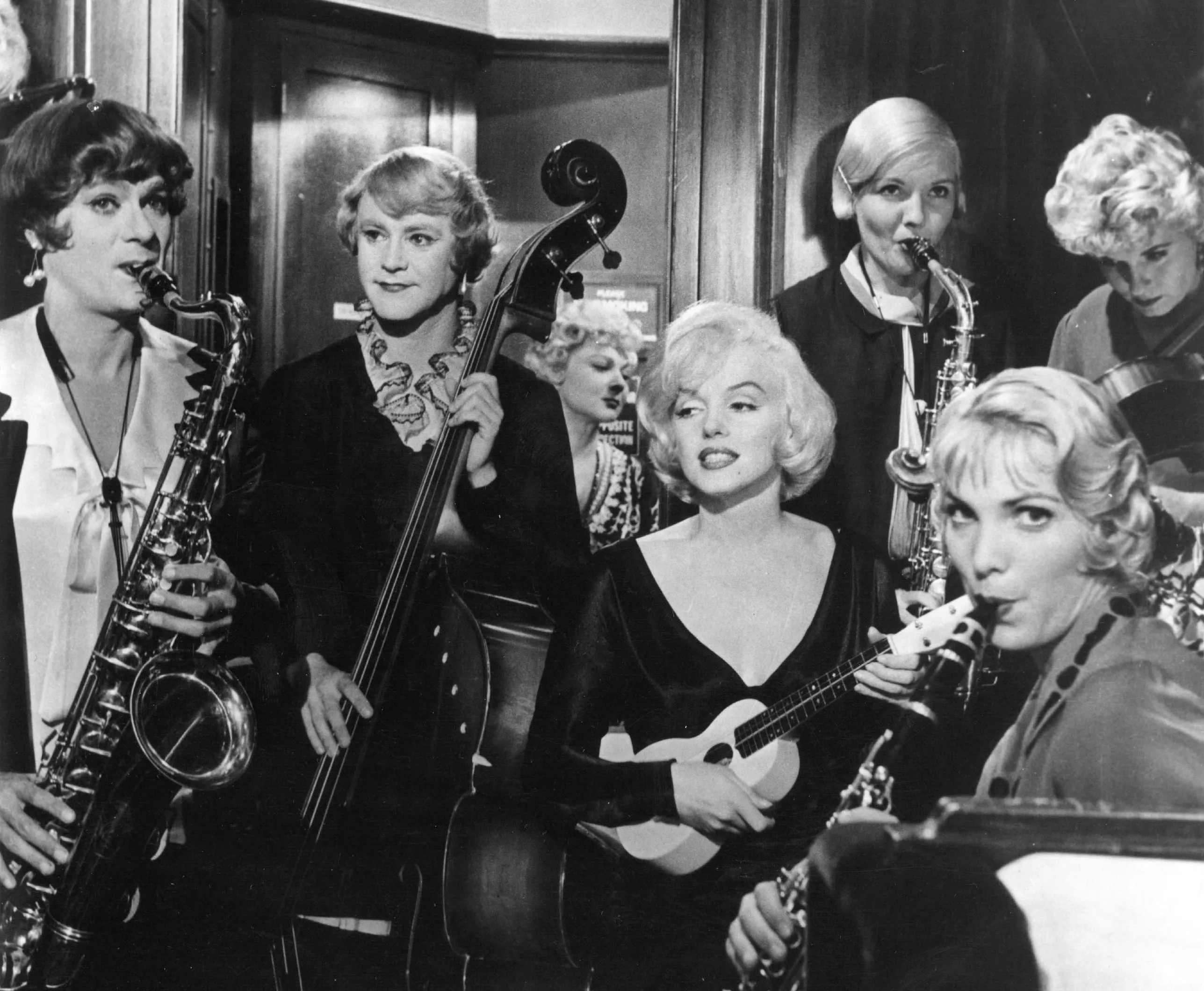The director Jean-Luc Godard once claimed, “Cinema is the most beautiful fraud in the world.” Joe and Jerry in Billy Wilder’s “Some Like It Hot” are two of the most beautiful frauds in all of cinema. These impoverished musicians, living in Chicago in 1929, try to make a living performing in speakeasies. En route to a gig, however, they accidentally witness the St. Valentine’s Day massacre. Desperate to escape the mafia, they are forced to take the only job they can find out of town — playing with an all-girl band in Miami. They dress in drag, adopting the personas of “Josephine” and “Daphne,” respectively. The lead singer in the band is Sugar Kowalczyk, played by Marilyn Monroe. Inevitably, Joe falls in love with Sugar, while Jerry is courted by an aging multimillionaire. Comic complications ensue.
Before he made “Some Like It Hot,” Wilder had made dramas about serious subjects. “The Lost Weekend” was a sobering examination of alcoholism, and “Stalag 17” was set in a Nazi POW camp. “Some Like It Hot” is about drag queens. Some might fault Wilder because he spent his skill making a frivolous film, yet, in “Some Like It Hot,” Wilder asserts that creating a carefree illusion can be just as illuminating as relaying an impactful story.
After all, artifice keeps Joe and Jerry alive. Initially, they see drag as merely a means to outmaneuver mobsters, but eventually, it becomes more than a disguise. As the film progresses, Joe and Jerry embrace their female personas; they become actors as well as musicians. Joe enjoys performing to such an extent that he adopts another guise altogether. Before the band arrives in Florida, Joe asks Sugar what she hopes to accomplish on the trip. Without hesitating, she responds that she is intent on ensnaring a handsome tycoon. She describes her ideal man down to the smallest detail — he wears glasses and is sweet and helpless. Infatuated with Sugar, Joe becomes determined to meet all her criteria. He pretends to be Shell Oil Jr., a bachelor who has made billions dealing in black gold. In doing so, Joe not only draws inspiration from Sugar’s firsthand description, but also from movies; Shell Oil Jr. is really an impersonation of Cary Grant. Of course, this is anachronistic — Grant did not become a star until the late 1930s, so no one in 1929 would have appreciated his suave manners. Indeed, Jerry can’t make sense out of Joe’s act. Poking fun at Joe’s debonair diction, Jerry asks, “Who talks like that, anyway?”
Obviously, no one does — even Grant himself did not use that accent in everyday life. Jerry’s question could also be asked of the gangsters in the film. The head of the syndicate in the film is called Little Bonaparte. That moniker recalls the name of a seminal 1931 gangster film, “Little Caesar.” Furthermore, Little Bonaparte and his associates all seem to have taken lessons from Edward G. Robinson, a renowned character actor, and not Al Capone. Wilder’s gangsters scowl more in two hours than Capone did in 48 years. Just as a real crook would not be as expressive as these movie mobsters, an ordinary singer in an all-girl band would not be as sultry as Marilyn Monroe. Perhaps Wilder should have cast a different actor in the part.
Interestingly, Wilder was almost forced to make the film without Monroe. She felt that she had played enough “dumb blondes” for one lifetime and sought to expand her range, but her husband, Arthur Miller, picked up the screenplay. Perhaps he admired how Wilder and his writing partner IAL Diamond revisit gags throughout the film. (For example, in an early scene, Jerry makes a comment that he has “type O” blood. The phrase “type O” recurs in the most unexpected moments — when Jerry and Joe witness the massacre, when Jerry tries to fend off the advances of a lascivious multimillionaire, and when Joe, as Shell Oil Jr., tells Sugar about his previous romances. By using this technique, Wilder and Diamond’s crazy comedy coheres.)
Monroe’s mistake was that she did not realize that it takes skill to write material for a “dumb blonde” and craft to portray one. No one talks like Shell Oil Jr. or the gangsters in reality, but that does not make watching them on screen any less of a pleasure. Audiences in 1959 flocked to see the film, but there was something subversive about its success. Wilder chose to release the film without approval from the Motion Picture Production Code so that he could use cross-dressing as a plot element, suggest homosexual entanglements and preserve his risqué humor. The film’s box office returns proved that the Production Code’s seal was not necessary to make a profit. Two beautiful frauds, one dumb blonde and a myriad of movie mobsters succeeded where noble, valiant heroes had failed. This ingenious work of illusion was able to elude the censors. With the Production Code gone, filmmakers would have a field day tackling touchy themes that had previously been forbidden. Perhaps some critics would rather revisit those films than this one. Still, even if it does not concentrate on an issue dragging humanity down, let it be said that “Some Like It Hot” never drags.
Contact Amir Abou-Jaoude at amir2 ‘at’ stanford.edu.
